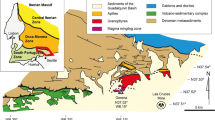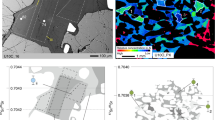Abstract
Layered basic intrusions can record processes which operated within basic magma chambers. In particular processes such as magma mixing and fractionation can be identified from the chemistry of cumulus minerals. Isotopes have been used to identify contamination in lavas1–6, but they can also be applied to cumulates to infer a continuous record of the interactions of crust and magma within the magma chamber. We report here that olivine compositions, rare earth elements (REE) on mineral separates and Sr isotopes on whole rocks and pyroxenes from unit 9 of the Eastern Layered Series of the Tertiary Rhum intrusion, north-west Scotland, suggest that fresh magma entered the chamber and mixed with fractionated and contaminated magmas at the base of the chamber. With prolonged residence in the chamber the fresh magma became fractionated and contaminated, was then erupted off and replaced by fresh magma which produced the basal peridotites of unit 10.
This is a preview of subscription content, access via your institution
Access options
Subscribe to this journal
Receive 51 print issues and online access
$199.00 per year
only $3.90 per issue
Buy this article
- Purchase on Springer Link
- Instant access to full article PDF
Prices may be subject to local taxes which are calculated during checkout
Similar content being viewed by others
References
DePaolo, D. & Wasserburg, G. Geochim. cosmochim. Acta 43, 615–627 (1979).
James, D. E. Earth planet. Sci. Lett. 57, 47–62 (1982).
DePaolo, D. Earth planet. Sci. Lett. 53, 189–202 (1982).
Moorbath, S. & Welke, H. Earth planet. Sci. Lett. 5, 217–230 (1969).
Moorbath, S. & Thompson, R. N. J. Petrol. 21, 295–321 (1980).
Dickin, A. P. J. Petrol. 22, 155–189 (1980).
Brown, G. M. Phil. Trans. R. Soc. B240, 1–53 (1956).
Huppert, H. E. & Sparks, R. S. J. Contr. Miner. Petrol. 75, 279–289 (1980).
Roeder, P. L. & Emslie, R. F. Contr. Miner. Petrol. 29, 275–289 (1970).
Dunham, A. C. & Wadsworth, W. J. Min. Mag. 42, 347–356 (1979).
Vollmer, R. et al. Geotherm. Res. 11, 317–327 (1981).
Sneeringer, M. & Hart, S. EOS 59, 402 (1978).
Taylor, H. P. & Forester, R. W. J. Petrol. 20, 355–419 (1979).
Stosch, H. G., Carlson, R. W. & Lugmair, G. W. Earth. planet. Sci. Lett. 47, 263–271 (1980).
Thirlwall, M. F., Chem. Geol. 35, 155–166 (1982).
Author information
Authors and Affiliations
Rights and permissions
About this article
Cite this article
Palacz, Z. Isotopic and geochemical evidence for the evolution of a cyclic unit in the Rhum intrusion, north-west Scotland. Nature 307, 618–620 (1984). https://doi.org/10.1038/307618a0
Received:
Accepted:
Issue Date:
DOI: https://doi.org/10.1038/307618a0
This article is cited by
-
Braided peridotite sills and metasomatism in the Rum Layered Suite, Scotland
Contributions to Mineralogy and Petrology (2020)
-
Successive episodes of reactive liquid flow through a layered intrusion (Unit 9, Rum Eastern Layered Intrusion, Scotland)
Contributions to Mineralogy and Petrology (2014)
-
Infiltration metasomatism in layered intrusions revisited: a reinterpretation of compositional reversals at the base of cyclic units
Mineralogy and Petrology (2008)
-
Mineral-scale Sr-isotope constraints on magma evolution and chamber dynamics in the Rum layered intrusion, Scotland
Contributions to Mineralogy and Petrology (2003)
-
Isotopic studies of processes in mafic magma chambers: II. The Skaergaard Intrusion, East Greenland
Contributions to Mineralogy and Petrology (1990)
Comments
By submitting a comment you agree to abide by our Terms and Community Guidelines. If you find something abusive or that does not comply with our terms or guidelines please flag it as inappropriate.



